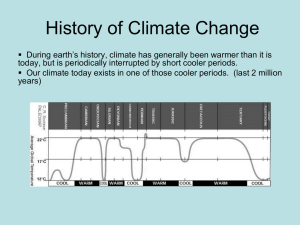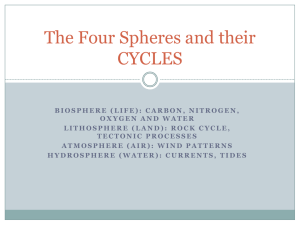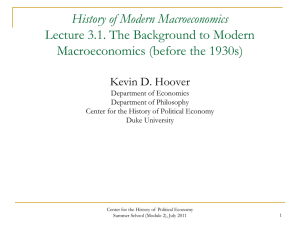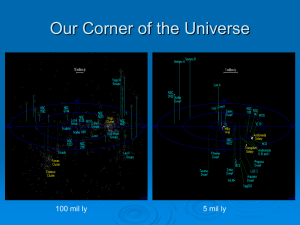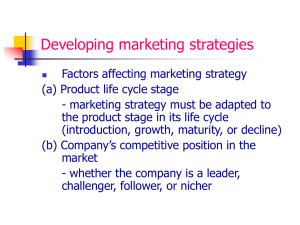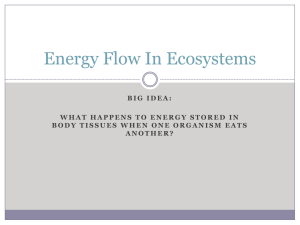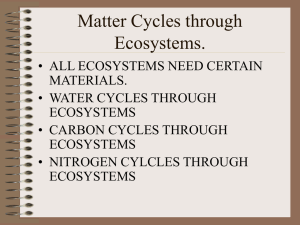Product Life Cycles
advertisement
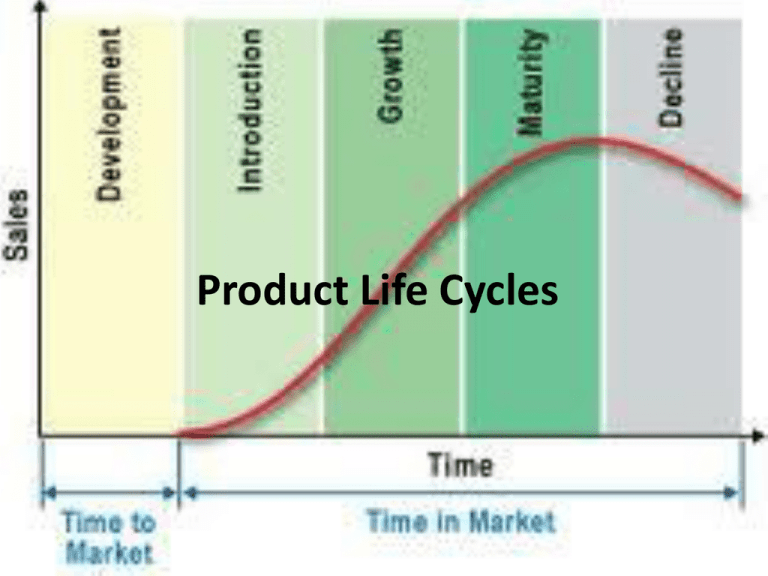
Product Life Cycles Product Life Cycles • Product life cycles describe the changes in consumer demand over time. No product can be in demand forever. Trends, technology and lifestyles change, which affects consumer demand. 2 Unit 2 Product Life Cycles Sales maturity decline growth decision point introduction Time • The traditional product life cycle consists of five stages. 3 Unit 2 Product Life Cycles • Introduction Stage • When a product is first introduced a product launch occurs. It may occur regionally, provincially, or nationally, depending on predicted demand. 4 Unit 2 Product Life Cycles • Introduction Stage • Launching a new product is very expensive, so initially the price is high. Costs involved include: machinery, set-up, training, promotion, storage, packaging, market research. – PS3 during the introduction stage was $900 – Microwaves when they were introduced cost $999 5 Unit 2 Product Life Cycles • Introduction Stage • Who buys at this stage? • Curious people, those who always want new things first: - early adopters - trendsetters. 6 Unit 2 Product Life Cycles • Introduction Stage • Main purpose of marketing is to inform the consumer about new products and to establish the value equation as early as possible. – Communicate the benefits that this product/service will offer you 7 Unit 2 Product Life Cycle • Products currently in introduction Sales Growth Stage growth Time Product Life Cycles • Growth Stage • After adopters find and use a product, others will follow. The product is visible, consumers see/hear others use it. Reputation spreads through word of mouth and advertising. 10 Unit 2 Product Life Cycles • Growth Stage • Manufacturers advertise heavily—will the product profit or fail? • The product may even be scrapped at this stage. If it is and it has lost money, it is called a bust. 11 Unit 2 Product Life Cycles • Growth Stage • The faster a product reaches the growth stage, the sooner it starts making a profit. • The first company to enter a market will pay the most for development and advertising, but it will have a major advantage: no competition. 12 Unit 2 Growth Stage Product Life Cycles • Growth Stage • As competitors enter the market, companies strive to maintain their market share: the company’s sales as a percentage of the total for the market. 14 Unit 2 Product Life Cycles • Growth Stage • Factors preventing companies from realizing profit are called barriers to entry. – These may include: • • • • small market size cost of R&D ad expenses equipment costs... 15 Unit 2 Product Life Cycles • Growth Stage • Eventually only the most competitive products remain on the market. Competitors stimulate market growth through advertising and wide distribution. 16 Unit 2 Product Life Cycles • Growth Stage • A company may produce a low-priced version of a product to establish a minimum price for a specific line, called a low-end product. Usually not sold under a well-known brand name. 17 Unit 2 Growth Stage Product Life Cycles • Maturity Stage • The period during which sales start to level off Sales maturity 19 Time Unit 2 Product Life Cycles • Maturity Stage • Marketers keep the brand name in front of consumers. Often the success and longevity of the product is highlighted. 20 Unit 2 Product Life Cycles • Maturity Stage • Because major costs have been recuperated and the cost of sales and distribution is low, products usually make large profits during this stage. 21 Unit 2 Product Life Cycles • Maturity Stage • Often times companies will take this profit to develop new products and product launches. • EXAMPLE: Disney took profits from its amusement parks to launch a cruise ship line. This also expands their brand name into a new market. 22 Unit 2 Maturity Stage (LONG TIME) Maturity Stage (Shorter Time) Product Life Cycles • Decline Stage • Occurs when a company cannot find new consumers for their product. Profits decrease; marketers try to find the reason for the decline. Sales decline 25 Time Unit 2 Product Life Cycles • Decline Stage • If it is a temporary decline – it may be reversed by a small price – change in the design – new ad campaign – Change in the packaging 26 Unit 2 Decline Stage 27 Unit 2 Product Life Cycles • Decision Point Stage The final stage of the product life cycle. Marketers must make important decisions regarding a product’s future. Sales • decision point 28 Unit 2 Time Product Life Cycles • Decision Point Stage • A product may be reformulated, repackaged, and reintroduced. • Most often maintenance of a product involves new promotion and new pricing. 29 Unit 2 Product Life Cycles • Decision Point Stage • If it looks like there is little hope for significant profit–due to market saturation, decreased demand, or otherwise–a suggestion may be made to abandon the product. 30 Unit 2 Nontraditional Product Life Cycles Nontraditional Product Life Cycles • Fads 32 Unit 2 Nontraditional Product Life Cycles • Fads • A product which is extremely popular for a very brief period of time, and loses popularity just as quickly. Robotic Pets, Cabbage Patch Kids, hummers, Pet rock, “that’s hot” 33 Unit 2 Nontraditional Product Life Cycles • Fads • Fads are unpredictable, and high-risk. Companies try to get out of the market just as the fad peaks. If they wait too long, they get stuck with excess inventory. 34 Unit 2 Nontraditional Product Life Cycles • Trends 35 Unit 2 Nontraditional Product Life Cycles • Trends • A trend has a more lasting effect on the market than a fad. A trend is usually a movement towards a style of product. Organic foods, Booster Juice, Social Networking, cell phones, Online Shopping 36 Unit 2 Nontraditional Product Life Cycles • Niche Markets 37 Unit 2 Nontraditional Product Life Cycles • Niche Markets • A small section of the market dominated by a small group of products. • Short growth, level maturity. The Pet Hotel, The Whistle, sweetener packets, 38 Unit 2 Nontraditional Product Life Cycles • Seasonal Markets 39 Unit 2 Nontraditional Product Life Cycles • Seasonal Markets • Consumer demand changes and is effected by the weather. Marketers anticipate periods of high and low demand, and work to create offseason opportunities. Ice cream parlours, resorts, lawn mowers, snow shovels, ice skates 40 Unit 2 ACTIVITY • Complete the “Product Life-Cycle with musical artists – Find an 5 musical artists that are currently in each stage of the product life cycle • Introduction – Just being introduced to the public – almost “underground” • Growth – is starting to make it big • Maturity – popularity has been steady • Decline – getting less and less popular by the year • Decision Point – either needs to redefine their career using AutoTune or should star on Celebrity Re-hab 41 Unit 2
